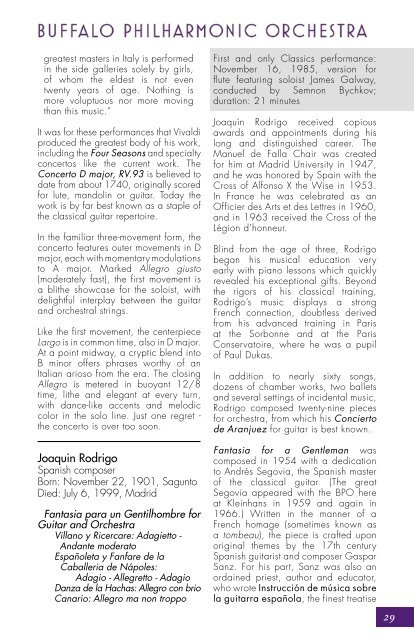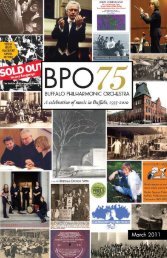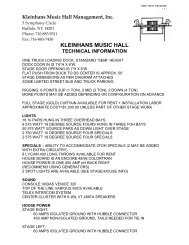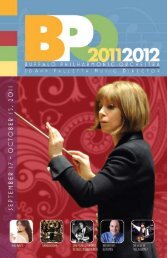Untitled - The Buffalo Philharmonic Orchestra
Untitled - The Buffalo Philharmonic Orchestra
Untitled - The Buffalo Philharmonic Orchestra
You also want an ePaper? Increase the reach of your titles
YUMPU automatically turns print PDFs into web optimized ePapers that Google loves.
greatest masters in Italy is performed<br />
in the side galleries solely by girls,<br />
of whom the eldest is not even<br />
twenty years of age. Nothing is<br />
more voluptuous nor more moving<br />
than this music.”<br />
It was for these performances that Vivaldi<br />
produced the greatest body of his work,<br />
including the Four Seasons and specialty<br />
concertos like the current work. <strong>The</strong><br />
Concerto D major, RV.93 is believed to<br />
date from about 1740, originally scored<br />
for lute, mandolin or guitar. Today the<br />
work is by far best known as a staple of<br />
the classical guitar repertoire.<br />
In the familiar three-movement form, the<br />
concerto features outer movements in D<br />
major, each with momentary modulations<br />
to A major. Marked Allegro giusto<br />
(moderately fast), the first movement is<br />
a blithe showcase for the soloist, with<br />
delightful interplay between the guitar<br />
and orchestral strings.<br />
Like the first movement, the centerpiece<br />
Largo is in common time, also in D major.<br />
At a point midway, a cryptic blend into<br />
B minor offers phrases worthy of an<br />
Italian arioso from the era. <strong>The</strong> closing<br />
Allegro is metered in buoyant 12/8<br />
time, lithe and elegant at every turn,<br />
with dance-like accents and melodic<br />
color in the solo line. Just one regret -<br />
the concerto is over too soon.<br />
Joaquin Rodrigo<br />
Spanish composer<br />
Born: November 22, 1901, Sagunto<br />
Died: July 6, 1999, Madrid<br />
Fantasia para un Gentilhombre for<br />
Guitar and <strong>Orchestra</strong><br />
Villano y Ricercare: Adagietto -<br />
Andante moderato<br />
Españoleta y Fanfare de la<br />
Caballeria de Nápoles:<br />
Adagio - Allegretto - Adagio<br />
Danza de la Hachas: Allegro con brio<br />
Canario: Allegro ma non troppo<br />
First and only Classics performance:<br />
November 16, 1985, version for<br />
flute featuring soloist James Galway,<br />
conducted by Semnon Bychkov;<br />
duration: 21 minutes<br />
Joaquín Rodrigo received copious<br />
awards and appointments during his<br />
long and distinguished career. <strong>The</strong><br />
Manuel de Falla Chair was created<br />
for him at Madrid University in 1947,<br />
and he was honored by Spain with the<br />
Cross of Alfonso X the Wise in 1953.<br />
In France he was celebrated as an<br />
Officier des Arts et des Lettres in 1960,<br />
and in 1963 received the Cross of the<br />
Légion d’honneur.<br />
Blind from the age of three, Rodrigo<br />
began his musical education very<br />
early with piano lessons which quickly<br />
revealed his exceptional gifts. Beyond<br />
the rigors of his classical training,<br />
Rodrigo’s music displays a strong<br />
French connection, doubtless derived<br />
from his advanced training in Paris<br />
at the Sorbonne and at the Paris<br />
Conservatoire, where he was a pupil<br />
of Paul Dukas.<br />
In addition to nearly sixty songs,<br />
dozens of chamber works, two ballets<br />
and several settings of incidental music,<br />
Rodrigo composed twenty-nine pieces<br />
for orchestra, from which his Concierto<br />
de Aranjuez for guitar is best known.<br />
Fantasia for a Gentleman was<br />
composed in 1954 with a dedication<br />
to Andrés Segovia, the Spanish master<br />
of the classical guitar. (<strong>The</strong> great<br />
Segovia appeared with the BPO here<br />
at Kleinhans in 1959 and again in<br />
1966.) Written in the manner of a<br />
French homage (sometimes known as<br />
a tombeau), the piece is crafted upon<br />
original themes by the 17th century<br />
Spanish guitarist and composer Gaspar<br />
Sanz. For his part, Sanz was also an<br />
ordained priest, author and educator,<br />
who wrote Instrucción de música sobre<br />
la guitarra española, the finest treatise<br />
29






